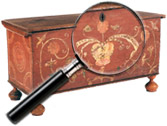|
|
Stephen Morgan Etnier, (1903-1984)
A painter of landscapes, marine, portrait and genre, Stephen Etnier was born in York, Pennsylvania, and maintained studios in New York City , South Harpswell and Popham Beach, Maine. He studied at the Yale Art School, and the Pennsylvania Academy of the Fine Arts and privately with Rockwell Kent and John Carroll.
A major 1998 retrospective of Etnier’s work at the Portland Museum of Art, Journeys Over Water, helped awaken [...] Click here to continue reading.
Wharton Harrris Esherick (1887-1970)
Living in a remote area by Valley Forge near Philadelphia, Wharton Esherick built his homestead and work place in the 1920s and left a legacy of bridging art with craftsmanship. Many of his works reflect the Art Deco style, and his distinctive furniture designs made him a pioneer of the decorative arts. He had little use for straight lines, and his structures are full of swirls and spirals, with an [...] Click here to continue reading.
Jacob Ernst
Jacob Ernst is listed in the Frederick County, Maryland 1790 census and deed dated 1811. Later listed as gunsmith in 1810 tax roll of Paradise Township, York County, Pennsylvania.
Re: Gunsmiths of York County PA, Whisker, pg. 7; Thoughts on the Kentucky Rifle, Kindig, pg. 357.
Ensi Rugs
Ensi, Engsh (Turkish). Translated in Turkish “ensi” or “engsi” (or in Persian “pardeh” or “purdah”) means curtain and is used when describing a felt or pile rug hung over the door of Turkoman tents. The pile of an ensi design usually includes four compartments with divisions creating a cross or “khatch” in the center of the rug.
John Joseph Enneking (1841-1916)
Landscape artist John Joseph Enneking was born in 1841 in Minster, Ohio. Enneking’s career as an artist began soon after he was severly wounded while serving in Union Army during the American Civil War. In 1868, he relocated from Cincinnati to Boston to study the trade of lithography and to paint landscapes. The popularity of his landscapes increased greatly after his return from an extended visit to France in [...] Click here to continue reading.
English Barometers
OverviewIn an age when life itself depended on successful agriculture, sailing ships and horse-back or foot travel a knowledge of the weather was essential. Weather forecasting primarily relied on observation of the skies until circa 1645 when an Italian mathematician, Evangelista Toricelli (1609 to 1647), discovered the scientific principles that led to the mercurial barometer. By using a long, thin glass tube closed at one end, and with the open end placed [...] Click here to continue reading.
Lydia Field Emmet (1866-1952)
Portraitist Lydia Emmet is especially known for her juvenile subjects. Born in New Rochelle, New York, she was one of ten children. Emmet learned to draw informally by herself in spite of the painting traditions of her family. At eighteen, she traveled to Paris with her sister, Rosina Emmet Sherwood, and studied at the Julian Academy. On her return, she worked as an illustrator of books and magazines, experimented with [...] Click here to continue reading.
Dudley Emerson
Born in Lyme in 1765, little is know of Emerson’s early years. By 1788 he had finished his apprenticeship and advertised in the Connecticut Gazette that his “Clock & Watch-making & Jewelry” business was open and located “on the road from New London to East Haddam” (Hoopes, Connecticut Clockmakers of the Eighteenth Century, New York, 1930, page 76). Emerson touted that he made “Chime Clocks that carry hours, minutes and seconds, day [...] Click here to continue reading.
Smith Ely (American, 1800 to 1884)
Smith Ely was a turner, chair maker, and merchant whose shop was at Broad and New Streets in New York, ca 1823-1837. He also sold undecorated chairs to other manufacturers who then decorated and sold them. See Monkhouse and Michie, The Magazine Antiques, June 1982.
Information courtesy of Cowan’s Auctions Inc.
Nick Eggenhofer (1897-1985)
At the height of his career, Nick Eggenhofer was known as the “King of the Pulps” for his western dry-brush illustrations. No one could touch him for the authenticity and raw honesty of his subjects. As a young immigrant from Germany, he had steeped himself in the lore of the frontier West, accumulating guns, chaps, Indian headdresses and other props, even building models of everything from stagecoaches to ore wagons to [...] Click here to continue reading.
|
Recent Articles
- Charles Alfred Meurer – American Artist & Tromp L’Oeil Artist
- Sendak, Maurice – American Artist & Writer
- Godie, Lee – American Artist
- Davis, Vestie – American Artist
- Bartlett, Morton – American Artist
- Mackintosh, Dwight – American Artist
- Evans, Minnie Jones – African-American Artist
- Mumma, Ed (Mr. Eddy) – American Artist
- Nice, Don – American Artist
- Savitsky, John (Jack) – American Artist
- Gordon, Harold Theodore (Ted) – American Artist
- Dial, Thornton – African-American Artist
- Doyle Sam – American Artist
- Johnson, Lester Frederick – American Artist
- Finster, Howard – American Artist
|
|
